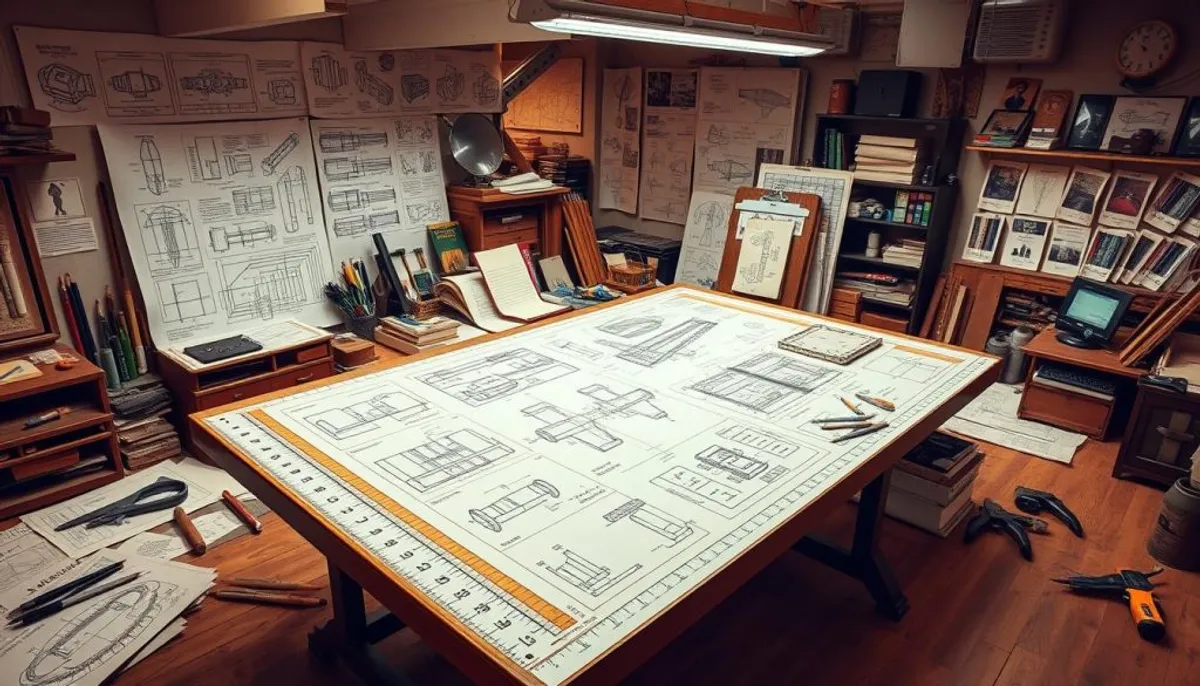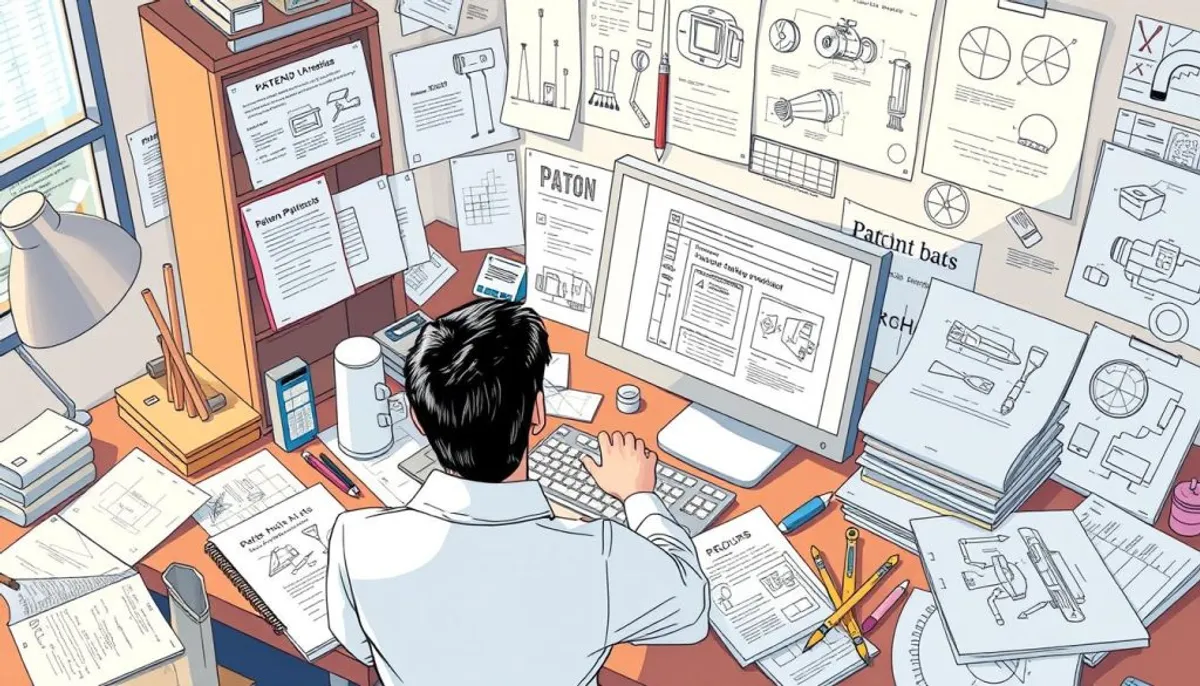Starting to protect a brilliant idea means drafting a patent. Many inventors have shown how a single idea can change the world. Works like the light bulb and the internet came from ideas. If an idea works well, it could be worth millions.
To make money from your idea, you must claim you own it. This is why patent drafting is so important.

Key Takeaways
- Patent drafting is the process of preparing and filing a patent application to protect an innovative idea.
- Proper patent drafting is crucial to securing intellectual property rights and preventing patent infringement.
- Understanding the key elements of patent drafting, such as clear and specific language, is essential for a successful patent application.
- Avoiding common mistakes in patent drafting, like lack of clarity and ignoring prior art, is critical to the success of your patent.
- Drafting a well-written patent specification can help you market and promote your scientific research and inventions.
Introduction to Patent Drafting
In the world of innovation, patent drafting is key. It turns new ideas into legal assets. A good patent protects an invention and sets its legal limits.
Understanding Patents and Patent Drafting
Patents give inventors the right to their invention for 20 years from filing. This lets them make money from their work without competition.
Significance of Patent Drafting
Patent drafting is crucial for protecting an inventor’s work. A strong patent application not only protects the invention but also attracts investors and customers.
Good patent drafting needs knowledge of patent law and the invention’s details. It helps inventors keep their ideas safe and ready for the market.
Key Elements of Patent Drafting
Drafting a strong patent application is key to protecting your new ideas. It includes the title, background, summary, detailed description, drawings, claims, and abstract. Each part is crucial for a well-made and legal patent application, patent claims, and patent specification.
The title should be short and match the invention well. The background sets the scene by talking about the technical area and the problems it faces. The summary gives a quick look at the main parts of the invention and how they work together to solve the problem.
The detailed description is the core of the patent application. It explains the invention fully. The claims set the limits of what the invention covers, and the abstract gives a brief summary of the invention’s main features. Good drawings can make the patent drafting clearer and more effective.
By focusing on each element, you can make sure your patent application is strong, complete, and legally solid. This protects your important intellectual property well.
Best Practices for Patent Drafting
Creating a successful patent application means following best practices in patent drafting. Key to these practices are clear language and making sure the invention is fully explained. This includes showing the best way to make the invention work.
Clear and Specific Language
The patent should be written in simple, clear language. Inventors need to explain their invention in a way that’s easy for experts to get. It’s important to avoid vague or hard terms. The goal is to make the patent clear and understandable.
Enablement and Best Mode
Patent drafting must follow the rule of enablement. The invention’s details must be clear enough for experts to make it without a lot of trial and error. Also, the best way to make the invention should be shared, as the law requires. This makes sure people know the best way to use the invention.
Other important tips include checking the prior art to show what’s new, defining the claims well, and following all laws and rules. Following these tips helps inventors get a strong, useful patent.
| Best Practices | Description |
|---|---|
| Clear and Specific Language | Use clear, concise, and unambiguous language to describe the invention in a manner easily understood by a person skilled in the relevant field. |
| Enablement | Ensure the description of the invention is sufficiently detailed to enable a person skilled in the art to practice the invention without undue experimentation. |
| Best Mode | Disclose the best mode of carrying out the invention, as required by patent law, to provide the public with the most effective way to utilize the claimed invention. |
| Prior Art Search | Thoroughly search the prior art to highlight the inventive step and differentiate the invention from existing technologies. |
| Claim Scope | Accurately define the scope of the claims to protect the invention effectively. |
| Legal Compliance | Ensure the patent application complies with all legal and regulatory requirements. |
By following these patent drafting best practices, inventors can boost their chances of getting a strong patent. This protects their new ideas well.

What is NOT Considered Patent Drafting
Patent drafting has its own rules. Some people think certain documents are part of it, but they’re not. These documents are not what you should submit.
An essay or business plan outlining the invention is often given by inventors. But, these aren’t what you need for a patent application. They focus on what might happen in the future, not what’s already been done.
Also, journal articles describing the invention as being congruent with established research aren’t enough. Patenting is for new and unique ideas, not just fitting into current research.
The technical requirements for a patent draft are very specific. They go way beyond what’s in business plans or journal articles. Patent drafting needs a detailed and thorough description of the invention.
In short, while these documents might tell you something about the invention, they’re not part of the patent drafting process. That process has its own rules and details.
Common Mistakes in Patent Drafting
Drafting a patent is a complex task. Even experts can make mistakes. Some common errors include lack of clarity and specificity, ignoring prior art, insufficient enablement, weak or overreaching claims, and neglecting the best mode requirement.
Lack of Clarity and Specificity
Using unclear language can make claims vague. This can weaken the patent’s protection. It’s important to use clear and specific words to describe the invention accurately.
Ignoring Prior Art
Not searching for prior art can lead to rejection or invalidation. It’s key to check existing patents and research thoroughly. This ensures the invention is new and meets patent requirements.
Other mistakes include not providing enough details for others to make the invention. Claims can also be too broad or narrow. These errors can weaken the patent’s protection.
To draft a successful patent, one needs to know patent law well. It’s important to pay attention to details and ensure the invention is fully described. Avoiding these mistakes can help get a strong patent.
Drafting a Patent Specification: An Illustration
The patent drafting process is key to protecting your new ideas. When writing a patent specification, focus on showing how unique and creative each part of your invention is. Start by making a patent claim strategy that mixes newness with creativity.
Your patent’s title should be short and match the invention’s main points without using hard words. The background section should explain the current tech (prior art) and the problem your invention fixes. The object of the invention should clearly state what your creation aims to do.
| Key Elements | Importance |
|---|---|
| Concise Title | Accurately reflects the invention’s subject matter and features |
| Detailed Background | Provides context on the existing technology and the problem to be solved |
| Clear Object | Defines the goal and purpose of the invention |
By taking care with each part of the patent specification, you can show the patent office and others the special value of your invention.

Patent Drafting: Protecting and Promoting Scientific Research
Marketing is key in making scientific research more useful and widely used. In patent drafting, marketing has three main parts: past, present, and future.
The past activities build trust between research groups. The present activities meet the needs of the parent organization. The future activities show how the research can benefit businesses.
Marketing in Patent Drafting
A patent aimed at promotion should highlight the inventor’s work in three areas: basic, applied, and business. This method helps protect and promote scientific research together.
- Fundamental level: Describe the basic science and theories behind the invention.
- Applied level: Explain how the invention uses science to solve a problem or meet a need.
- Business level: Show the invention’s business potential and its marketing and patent promotion benefits.
This approach helps create a patent that protects the patent drafting and boosts the scientific research it represents. It encourages people to use and sell the research.
patent drafting: Strategies and Considerations
Creating a winning patent application needs a strategic plan. As an expert in intellectual property, knowing how to draft patents is key to protecting your new ideas. Here are some important tips and things to think about:
First, it’s vital to clearly and briefly define your invention. Your application must give a detailed and clear description of what you’ve made. This makes sure your invention’s special parts and how it works are well explained. Being clear helps strengthen your patent and makes patent enforcement easier later.
Doing a deep prior art search is also crucial. This means looking into existing patents and papers to find any issues. It helps make sure your invention is new and not obvious. This info helps you pick the right type of patent, like a utility, design, or plant patent.
- Clearly define your invention’s unique features and functionalities.
- Conduct a thorough prior art search to identify potential challenges and select the appropriate patent type.
- Adhere to patent office guidelines and ensure full disclosure of your invention’s details.
- Structure your patent application in a way that enhances enforceability and meets legal requirements.
Successful patent drafting is about blending legal knowledge, technical skills, and a strategic approach. By thinking about these important points, you can protect your intellectual property well. This sets your innovation up for success in the market.
| Strategy | Consideration |
|---|---|
| Clear Invention Definition | Provide a detailed and unambiguous description of your creation’s unique features and functionalities. |
| Prior Art Search | Thoroughly research existing patents and publications to identify potential roadblocks and select the appropriate patent type. |
| Adherence to Guidelines | Ensure your patent application adheres to patent office guidelines and fully discloses all relevant details of your invention. |
| Enhancing Enforceability | Structure your patent application in a way that maximizes the enforceability of your patent protection. |
Conclusion
Drafting a patent is key to protecting your innovative ideas. It keeps your intellectual property safe and helps you stay ahead in your field. Knowing about patent drafting, like using clear language and following best practices, helps make a strong patent application.
A good patent not only protects your rights but also helps you share and make money from your invention. It’s important to avoid mistakes, like unclear language and ignoring past inventions, to make sure your patent is approved and can be defended.
For scientists, engineers, or entrepreneurs, learning about patent drafting is crucial. It helps protect your patent rights and brings out the best in your innovative ideas. By creating a detailed and strong patent, you set your invention up for success and keep moving forward in your field.
RelatedRelated articles

